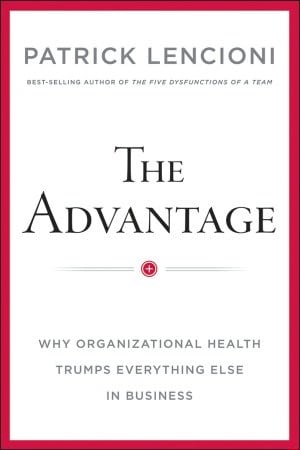 If you lead part or all of any organization, then you need to read The Advantage by Patrick Lencioni. Drawn from his decades of work in business management consulting, his insights into organizational health are a must read, whether you’re a business owner, school principal, or pastor.
If you lead part or all of any organization, then you need to read The Advantage by Patrick Lencioni. Drawn from his decades of work in business management consulting, his insights into organizational health are a must read, whether you’re a business owner, school principal, or pastor.
I first encountered Lencioni through the Catalyst Conference. Every time I heard him speak I walked away impressed with his insight into organizational health. This year, I bought his book, his “how-to” manual on organizational health. It’s been one of the top three books I’ve read all year (for a guy who reads dozens and dozens of books a year, that’s at least saying something).
The Advantage is simply this: “The single greatest advantage any company can achieve is organizational health. Yet it is ignored by most leaders even though it is simple, free, and available to anyone who wants it” (1). The reason organizational health is ignored is because it’s intangible, theoretical, touchy-feely and difficult to quantify. It’s easier to stay in the concrete world of numbers and profits. And yet, tangible metrics are only part of success. Lencioni correctly states that for a business to succeed, it needs to be smart and healthy.
Being ‘smart’ is what we know: offering the best products, having the best marketing, staying ahead of technology. Being ‘healthy’ is something altogether different: minimal politics and confusion, high degrees of morale and productivity, and very low turnover from good employees (5). And yet, both are absolutely critical.
You’ve walked into business environments that were smart but unhealthy. Your experience was probably horrible. Literally the night before I wrote this review, my family and I went to a restaurant that had spent tens of thousands of dollars renovating their restaurant. The exterior and interior looked fresh, new, and modern. There was even a state of the art play area for my children. Yet at the end of the experience, my wife and I vowed never to return there. Why? Not because it wasn’t smart (everything was slick and up-to-date), but because it was unhealthy. The employees were slow, rude, and uncaring to the customers. It was painfully obvious that they didn’t like working there, so there was no incentive to give their customers a positive experience. The food was mediocre, prepared in a haphazard way. They were out of several small items that you’d usually expect to go with a meal. The supplies were in the back, but no one had come to refill those items for customers to come and get. It was a horrifyingly frustrating experience. A smart organization that’s unhealthy will ultimately fail.
And it’s not that non-profits have the corner on organizational health. Just because they might have a loftier goal than simply making a profit won’t ensure that their organizations are healthy. I worked in three different churches in my first ten years of ministry. Some were healthy, some were disastrously unhealthy. The mission was the same, but organizational health had a huge impact on whether they were ultimately successful in their mission.
With the necessity of organizational health established, Lencioni walks the reader through his four stages of organizational health. As a warning, when you read these four steps, they will seem simplistic, perhaps not tangible or complicated enough to affect your organizational effectiveness. Don’t be fooled. These steps are an incredibly practical tool to help your organization become healthy:
- Build a cohesive leadership team.
- Create clarity.
- Overcommunicate clarity.
- Reinforce clarity.
Now as for the specifics for each of the four steps, I’ll let you discover them on your own. This is a book worth purchasing and taking your organization through. His chapter on meetings, for instance, has completely changed how I think of meetings and how I will lead meetings in the future. Whether leading a for-profit or non-profit, an organization will be successful only if it is healthy. The Advantage is worth the read. Trust me.
LESSONS LEARNED
1. Organizational health matters. I know this first-hand. As I stated previously, I’ve worked in three churches during my first ten years of ministry. Some may look at that as me simply “climbing the ministry ladder.” For me, it was more about finding an organization to work in that was healthy. If an organization is healthy, its employees won’t want to leave. The reason I believe there is such a high turnover rate among ministers is because so many churches are unhealthy as organizations. Pastors learn all the theology they need in seminary, but many times none of the leadership skills needed to create a healthy organization.
2. Organizational health trumps ‘smarts.’ In the companies Lencioni worked with throughout the years, he came across a number of healthy organizations that made ‘smart’ business decisions that helped the organization separate itself from its peers. He noted that the media would always attribute these decisions to the intellectual prowess of the leaders. Yet Lencioni found something different. Many of these leaders had only average or above average educations, and yet their organizations made smarter decisions than their competitors with Ivy League educations. Why? Because their environment was healthy enough to produce smart decisions (10).
3. Health must start at the top. Lencioni consistently states that organizational health must start with the point leader of the organization. If the leader is unwilling to roll his or her sleeves up and embrace the process of organizational health, then it will never happen. If I believe the work of organizational health is beneath me, then my organization will never be healthy.
4. Churches are not immune to the requirements of organizational health. In his section on building a cohesive leadership team, Lencioni speaks against artificial harmony, which can destroy trust among the leadership. He states, “Nowhere does this tendency towards artificial harmony show itself more than in mission-driven nonprofit organizations, most notably churches. People who work in those organizations tend to have a misguided idea that they cannot be frustrated or disagreeable with one another” (44). Churches have to work at organizational health like everyone else.












